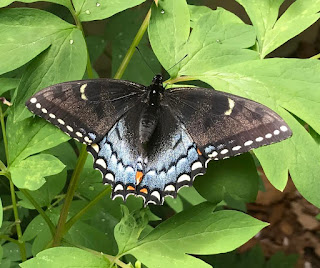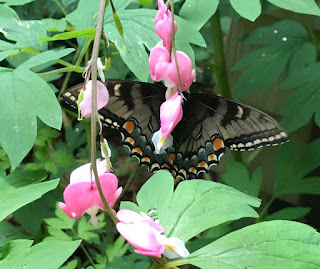We've managed to get out on the local streams fairly often in the last couple of weeks, and the fishing has been great some days, and not so great on others. Plenty of insects have been hatching, yet the dry fly action has been as variable as the weather. One day its hot and the next wet and cold. All of the rain is keeping the rivers up, so there are no complaints here. And when the fish are not looking up, I've had great success with one pattern, the Iris Caddis fished dead-drift. I've always had good success with this pattern fishing it as an emerger in the film during a caddis emergence, but after my friend Chris told me a few years back it also works fished wet, I've found it to be one of my go-to patterns in the spring and summer months when caddis area present but nothing is rising. This past Saturday I fished with Vinnie on the South Branch, and between the two of us, we caught more fish than we could count. I got most of my fish on the Iris Caddis you see here.

(A well-chewed, size #15, Iris Caddis)
Yes, its a size #15. The hook is a Tiemco 102Y, which is sized using odd numbers, and is the hook the fly is traditionally tied on. It is a down eye, 1X fine, wide gape, forged hook that is black anodized. Lacking a source for this hook, a size # 14 or 16 dry fly hook will work just fine. I use them when I can't find the 102Y.
There have been plenty of bugs hatching, and when the fish are looking up, the dry fly fishing has been very good. Locally, North Jersey, we have had sulphurs, lemon cahills, light cahills, little blue-winged olives, large blue-winged olives, and the slate drakes have started. Then there are the various caddis that are hatching and/or egg-laying, including cinnamon or ginger caddis, dancing caddis, little dark granmoms, and a few lesser known species.

(Blue-winged olive - size #14 - Ephemerella cornuta)


(Dancing caddis - Mystacides sp. - size #18)


Sharpen your hooks!
The dancing caddis shown above has been present every day I've been on the river. They are often mistaken for the chimarra sp. caddis, as they are small, and jet black in color. The difference is that the dancing caddis has horns, long speckled antennae, and a unique folded wing shape that is twice as long as the body. You may have seen then dancing (fluttering) low over the surface of the water in small clouds. They are only important to the angler when they fall spent on the water after egg-laying. Otherwise, they hatch along the stream edge on rocks and other partially submerged limbs or logs.
Here's my go-to sulphur pattern - the sulphur usual. Tie them up in sizes #14-20 for all the light yellow mayflies that hatch for the next couple of weeks. Also, tie a few with cream bodies in size #14 to imitate the light cahills. It's a simple fly that takes fish consistently.


Sharpen your hooks!



